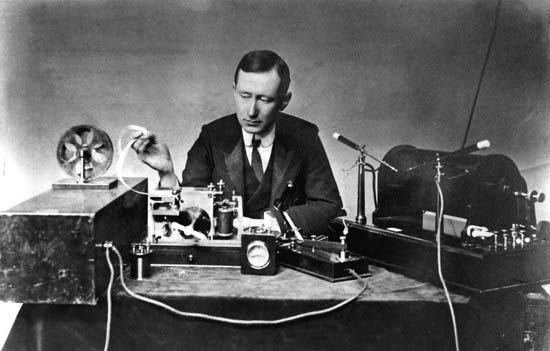In my village in mid-Cornwall the telephone was still something of a novelty when the first wireless sets appeared and although we didn’t understand how it worked, at least it had wires connected to it along which messages could travel. But here was a box of tricks which needed no wires from the outside, as Marconi demonstrated at Mullion in 1901, and could receive music and speech over great distances.

Radio communications had arrived but it would be some years before wireless sets became a common feature of entertainment in our homes. In the early 1920s there were no retail shops supplying ready-made sets and receivers were invariably built from kits of parts. Every locality had its wireless enthusiasts who dabbled in “Cat’s Whisker” crystal sets; often practical people who had some knowledge of elementary physics now that the teaching of science had reached the secondary schools. As sets were made and installed, invitations to “wireless evenings” were extended to friends and soon we were all caught-up in the wonder of this new technology. As my elderly grandfather remarked on listening to a wireless programme for the first time, “Tis a marvellous thing!” Transistors were comparatively low-powered -though “‘foreigners” seemed always to have powerful ones! – and it was essential that a good aerial system was installed in order to “pull-in” the programmes. It had to be fixed externally and the aerial wire fastened to a convenient tall tree or a special pole supported by guy wires: 30ft. or 40ft. was considered a suitable height. The post office placed a limit of 100ft. on the mast height. The wire entered the building at roof level and connected with the set in a room below. The areat fear felt by owners of these early receivers was the possibility of a lightning strike and elaborate precautions were taken to ensure a “good earth”. A wire soldered to a large biscuit tin and dug deep into the soil was connected to the aerial through a sturdy “knife” switch and fixed on the inside of the window frame. A nightly routine in the household would be to set the switch to earth at bedtime and I can well remember my father getting out of bed to check that his had been done! Our first receiver was built by a local buff who was moving up the constructors ladder to things bigger and better and was already hinting knowledgeably at something called “superhet”. The set was an impressive array of valves, coils and condensers, housed in a polished mahogany case with controls at the front, looking like a small sideboard; wavelengths were changed by lifting the lid and inserting plug-in coils. With its batteries and accoutrements it occupied most of the space in a bay window! One of the batteries was a heavy glass-bodied accumulator and this energy could be restored and I, as a small boy, was given the not unwelcome job of taking the spent battery “down Churchtown” and returning with the newly charged one. We were all caught up, quite soon, with listening as a family and enjoyed discovering new broadcasting stations and programmes coming over the air. Yet, reception in the early stages of wireless was somewhat indifferent, not only because of fading signals, atmospherics and a certain “clutter” in the airways but the loudspeaker was not invented and the listener had to rely on earphones. For communal listening this presented problems and ingenious devices were conceived to overcome them. One rather crude solution was to place the earphones in a large basin and seek amplification that way, though, even with a great deal of ear-straining, the result was not very satisfactory. However, when the loudspeaker arrived, we really were in clover! The ardent wireless enthusiasts would find the best reception by taking their equipment to high ground and I well remember hearing of a group who went to Bodmin Moor for this purpose. An elderly lady made her cottage available to them and when the aerial was fixed they tuned to the nearest local station, which was Bournemouth, to receive the B.B.C. Home Service. The morning service was being broadcast and prayers were being said whilst the usual basin was acting as amplifier for the earphones. The dear lady, who had never heard a wireless broadcast before, was astonished at this marvel of science and was moved to remark, “I never thought I’d live to hear the Lord’s Prayer cumin’ out of a puddin’ basin!” To those hearing these magic sounds for the first time it was little short of magic. Well the next 70 years were to see advances undreamt of in those early years and we would see the B.B.C. set the standard in global broadcasting and become one of the world’s most respected institutions. The invention of the transmitters has brought near perfect reception on long, medium, short and FM wavelengths. Although advances in hi-tech continue to amaze us all, my generation will be able to remember, with great affection, those far-off days ‘‘ then the wireless came to Cornwall.
